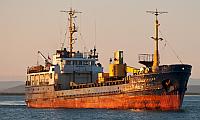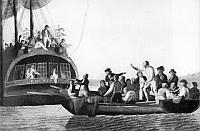Here on the west bank of the Hudson, we were in the path of Hurricane Sandy’s storm surge and winds. Though we came very close to flooding we didn’t quite go under. (We were very lucky.) We are have food, water and shelter. All we lack is phone, electricity and internet. So untill the lights go on, I will be difficult to contact. I have posts cued up for the next few days and wish everyone a good week.
Dramatic video from the Coast Guard of rescue of members of the crew of the HMS Bounty which sank off the North Carolina coast on Monday.

Photo: Igor Savitskiy on Shipspotting
The freighter Amurskaya, with a crew of of between 8 and 11, and carrying 700 tons of gold ore has been reported missing in stormy seas near the Shantar Islands, in the Sea of Okhotsk, on Russia’s Pacific Coast. The gold ore is estimated to be worth roughly $800,000. The general cargo vessel Amurskaya IMO 7313614, was built in 1973. Thanks to Phil Leon of contributing to the post.
UPDATE: Missing crew member, Claudene Christian, 42, was pulled from the water unconscious and later confirmed dead by the Coast Guard. Captain Robin Walbridge is still missing.
CBC News is reporting: Claudia McCann, whose husband Robin Walbridge is the captain of the Bounty, told CBC News her husband is one of the two missing crew members. CBC News has learned the other missing crew member is Claudene Christian.
Claudene Christian is reported to be a distant relative of Fletcher Christian, the original Master’s Mate who seized command of the ship during the mutiny.
I just heard an interview on CNN with a US Coast Guard Vice Admiral (I believe it was Vice Adm. Robert Parker, but I didn’t quite catch the name.) He said that three crew members were swept off the deck of HMS Bounty as she sank. All three crew were wearing survival suits. One of the three made it to the life raft. The other two did not. The Coast Guard continues searching. Nevertheless, the Vice Admiral noted how difficult it is to locate a person in the high winds and seas in the area where the ship sank.
The 180′ tall ship HMS Bounty has sunk off the North Carolina coast. At least 14 of the crew have been rescued. There is considerable confusion about the remaining 2-3 crew members. The Bounty organization reported that 17 crew, wearing survival suits and life jackets, had been accounted for in two lifeboats. The US Coast Guard now says that there 16 rather than 17 aboard the ship and that two are unaccounted for. The most recent message on the Bounty Facebook page reads: Please bear with us…There are so many conflicting stories going on now. We are waiting for some confirmation.
UPDATE: Coast Guard rescues 14, continues searching for 2 from HMS Bounty
Update: from the Bounty Facebook page 7:10 AM – At 0430 today the Captain ordered all hands to abandon ship. There are 17 Crew on board and at this moment all crew are accounted for and are in Life rafts. The first USCG helicopter has reached the ship and is in the process of rescuing them. Bounty is currently still floating upright and intact.
Terrible news. The 180-foot, three mast tall ship, HMS Bounty is reported to be in distress and the crew of 17 is reported to have abandoned ship, approximately 160 miles west of the eye of Hurricane Sandy in 35 knot winds and 18 foot seas.
After apparently successfully crossing the path of Hurricane Sandy yesterday, there were reports yesterday afternoon that a generator aboard ship had failed. The Bounty‘s Facebook page said that the ship was “taking on more water than they would like.” Late Sunday, the ship’s owners lost contact with the ship and notified the Coast Guard. Subsequently, the Coast Guard picked up an EPIRB distress signal from the ship. An air crew from Coast Guard Air Station Elizabeth City launched aboard an HC-130 Hercules aircraft, which later arrived on scene and reestablished communications with the Bounty’s crew.
 Faulkner wrote, “The past isn’t dead. It isn’t even past.” I was reminded of this when I read a wonderful post on Joan Druett’s blog this morning, The Mutiny on the Bounty. She vividly recreates the scene of the mutiny from the deck of the P&O cruise ship Pacific Jewel, which at that moment was lying in the exact spot on the Pacific where the famous mutiny on HMS Bounty took place in 1789. She describes to the nearly nearly 2000 passengers attending, how Captain Bligh and eighteen loyal crew are cast off in an overloaded launch. The cruise ship then sailed on the island of Tofua, where Bligh’s launch made landfall, only to attacked by natives. Bligh and his crew make a momentous decision. As Druett writes: They will stop at no more islands. Instead, they will make the 3,618-mile voyage to Timor, in the East Indies, skirting Fiji, Vanuatu, and the Great Barrier Reef, and then negotiating the scarcely charted Torres Strait. Living on one ounce of bread and a quarter pint of water each day, somehow they will do it — and without the loss of even one more man. It is the start of the most remarkable small boat voyage in history. Read the rest on Joan Druett’s World of the Written Word.
Faulkner wrote, “The past isn’t dead. It isn’t even past.” I was reminded of this when I read a wonderful post on Joan Druett’s blog this morning, The Mutiny on the Bounty. She vividly recreates the scene of the mutiny from the deck of the P&O cruise ship Pacific Jewel, which at that moment was lying in the exact spot on the Pacific where the famous mutiny on HMS Bounty took place in 1789. She describes to the nearly nearly 2000 passengers attending, how Captain Bligh and eighteen loyal crew are cast off in an overloaded launch. The cruise ship then sailed on the island of Tofua, where Bligh’s launch made landfall, only to attacked by natives. Bligh and his crew make a momentous decision. As Druett writes: They will stop at no more islands. Instead, they will make the 3,618-mile voyage to Timor, in the East Indies, skirting Fiji, Vanuatu, and the Great Barrier Reef, and then negotiating the scarcely charted Torres Strait. Living on one ounce of bread and a quarter pint of water each day, somehow they will do it — and without the loss of even one more man. It is the start of the most remarkable small boat voyage in history. Read the rest on Joan Druett’s World of the Written Word.
While those of us on the East Coast of the United States have been watching the approach of the “superstorm” Hurricane Sandy, residents of the Hawaiian islands were under a tsunami warning following a a powerful 7.7 magnitude earthquake that hit Canada’s Pacific coastal province of British Columbia late on Saturday. At least 100,000 people were advised to evacuated to higher ground on the warning. The warning was downgraded to an advisory – a lower-level alert – shortly after 1 a.m. Sunday.
Hawaii tsunami warning lifted after 100,000 flee to higher ground
A tsunami warning prompted by a powerful earthquake off the Canadian coast sent at least 100,000 people fleeing from shore to higher ground in Hawaii late on Saturday, but an evacuation order was canceled after a series of weaker-than-expected waves rolled through the islands.

Position of HMS Bounty
Tropical Storm Sandy returned to hurricane strength on Saturday morning as it heads toward the U.S. northeast coast. The US Navy as ordered 24 of the larger ships in southeastern Virginia bases, including the aircraft carrier USS Harry S. Truman, out to sea to avoid the storm. Those ships which cannot leave are taking extra precautions stay secure a their docks. Military installations along the Eastern Seaboard, including Andrews Air Force Base and Langley Air Force Base in Virginia and Naval Submarine Base New London in Connecticut were also prepared to move ships and aircraft if needed.
 Daina Shipping, owner of the container ship MV Rena, has been fined NZ $300,000 (US $246,000) for discharging harmful substances after the Liberian flagged ship, ran aground on the Astrolabe Reef off Tauranga, New Zealand in early October of last year. The ship subsequently broke up on the reef, resulting in the most serious maritime environmental disaster in New Zealand’s history.
Daina Shipping, owner of the container ship MV Rena, has been fined NZ $300,000 (US $246,000) for discharging harmful substances after the Liberian flagged ship, ran aground on the Astrolabe Reef off Tauranga, New Zealand in early October of last year. The ship subsequently broke up on the reef, resulting in the most serious maritime environmental disaster in New Zealand’s history.
The ship’s captain and chief engineer were found guilty of a total of eleven charges related to poor seamanship and attempting to cover up their actions by altering the ship’s GPS log, its passage plan and its computer records. Each was sentenced to seven months in jail.
The $300,000 fine is largely symbolic. After insurance, the cleanup from the Rena grounding cost New Zealand taxpayers an estimated $50 million.
 As Hurricane Sandy works its way north, it is possible that it will join with a nor’easter to form what meteorologists are referring to as a “Frankenstorm,” a superstorm that could slam into the US Northeast causing damage projected to be larger than that of last year’s Hurricane Irene, which totaled in the billions of dollars. “We’re not trying to hype it,” National Weather Service meterologist Paul Kocin tells Bloomberg News. “What we’re seeing in some of our models is a storm at an intensity that we have not seen in this part of the country in the past century.” Hurricane Sandy has already killed 41 people as it passed across the Caribbean. Hurricane Sandy is expected to come ashore in the Northeast on Monday or Tuesday.
As Hurricane Sandy works its way north, it is possible that it will join with a nor’easter to form what meteorologists are referring to as a “Frankenstorm,” a superstorm that could slam into the US Northeast causing damage projected to be larger than that of last year’s Hurricane Irene, which totaled in the billions of dollars. “We’re not trying to hype it,” National Weather Service meterologist Paul Kocin tells Bloomberg News. “What we’re seeing in some of our models is a storm at an intensity that we have not seen in this part of the country in the past century.” Hurricane Sandy has already killed 41 people as it passed across the Caribbean. Hurricane Sandy is expected to come ashore in the Northeast on Monday or Tuesday.
On an overcast Thursday morning, the 122-foot top-sail schooner Lynx arrived at North Cove in lower Manhattan on the Hudson River. See our recent post. She will be open to the public for dockside tours and sails on Saturday and Sunday, weather permitting. Public sails scheduled for Monday are looking less likely with the approach of Hurricane Sandy. For schedules and tickets click here. A few photos, click on the thumbnails for larger images:
- Privateer Lynx North Cove
- Privateer Lynx Stern
- Lynx Bow
- Masts & Buildings
- Jib Hanks
- Polishing the wheel
- Cathead
- Carronade
On Wednesday afternoon, the tug Benjamin Bailey rolled and suddenly capsized in the currents of the Piscataqua River. Fortunately the two crew men aboard managed to escape from the sudden capsize. The tug is owned by Ken Anderson of Riverside & Pickering Marine Contractors, based in Eliot, Maine and was working on the construction of the new Memorial Bridge connecting Portsmouth, N.H., to Kittery, Maine. There will be an attempt to raise the tug from the river on Friday. This is the second tugboat to sink this year in this section of the river. Both boats were working on the Memorial Bridge project.
 The annual Sultana Projects Downrigging Weekend, now in its twelfth year, is one of the largest annual tall ship and wooden boat festivals on the East Coast. The Downrigging Weekend is described as “a celebration of maritime culture, wooden boats, and everything else that makes the Chesapeake Bay great.” A fleet of tall ships is participating in addition to the schooner Sultana including the schooner Pride of Baltimore, the historical replica Kalmar Nyckel, the schooner Lady Maryland, the skipjack Elsworth, the schooner A.J. Meerwald and the skipjack Sigsbee.
The annual Sultana Projects Downrigging Weekend, now in its twelfth year, is one of the largest annual tall ship and wooden boat festivals on the East Coast. The Downrigging Weekend is described as “a celebration of maritime culture, wooden boats, and everything else that makes the Chesapeake Bay great.” A fleet of tall ships is participating in addition to the schooner Sultana including the schooner Pride of Baltimore, the historical replica Kalmar Nyckel, the schooner Lady Maryland, the skipjack Elsworth, the schooner A.J. Meerwald and the skipjack Sigsbee.
Adding a bit of spice to the weekend is Tropical Storm Sandy which is making its way north. So far the forecasts suggest that the Downrigging Weekend will be fine, though no doubt everyone will be keeping an eye out to weather.
The title may be a bit unfortunate, but it is an interesting documentary nevertheless, featuring the brigantine Tres Hombres. The documentary trailer is posted below. The entire documentary can be watched here.
Three weeks after the devastating earthquake on Haiti in 2010, eleven idealists depart from Holland with their self-build wooden sailing vessel Tres Hombres. Their mission is to help the people of Haiti. On board they bring a mix of aid supplies; pick axes, diapers, a scooter and even teddy bears. ‘The people in Haiti need our goods, that’s why we have to sail as fast as possible’ Captain Arjen van der Veen tells his crew. But in the never-ending waters, boredoms strikes and the good intentions of their heroic mission elaborate in heated discussions about the nearing end of the world. Does the Captain know what he is fighting for?
TRAILER How Captain Longhair saved the world from Maarten Kal on Vimeo.
After almost 51 years in service, twice its expected lifespan, the nuclear powered aircraft carrier USS Enterprise is winding up its 25th deployment and will be heading back to Norfolk to be deactivated on December 1 and decommissioned once all reusable items are removed. USS Enterprise was the world’s first nuclear-powered aircraft carrier and is the second oldest commissioned vessel in the United States Navy, after the wooden-hulled, three-masted frigate USS Constitution.
http://youtu.be/HtIv8RIbDbk
Beluga whale ‘makes human-like sounds’
Sailors once called beluga whales the “canaries of the sea.” Sailors could hear the “song” of the beluga, a range of chirps and whistles, through the wooden hulls of their ships. There is a fascinating story in the news these days about a beluga whale named NOC which started making some very unusual and non-beluga-like noises. NOC was captured in 1977 and became a part of the Navy’s Marine Mammal Program in San Diego. Around 1984, NOC started making sounds which divers mistook for human speech. NOC continued this behavior for around four years and then stopped. Now almost 25 years later, researcher Sam Ridgeway and his colleagues have published a paper on his vocalizations in the journal Current Biology. Thanks to Phil Leon for contributing to this post.
 This Sunday there will be a full day benefit for the historic Fireboat John J. Harvey on Pier 66 (26th and the Hudson River) in New York. It looks like lots of fun.
This Sunday there will be a full day benefit for the historic Fireboat John J. Harvey on Pier 66 (26th and the Hudson River) in New York. It looks like lots of fun.
The festivities are divided into two parts. From 1-5pm the focus is Family Fun featuring face-painting, pumpkin painting, ‘tour-the-grant’ tours, short boat-rides on the fireboat as weather allows, celebrity readings of ‘Fireboat’, hot dogs, soda, hamburger sliders, cole slaw, potato salad, pasta salad and on-going silent auction or raffles. Tickets are $25 for adults and $15 for children.
From 5 to 7pm, there will be a Gala Sunset Cocktail Party with Grammy Award Winner Rosanne Cash and Tony Award Winner Alan Cumming and hosted by The inimitable Florent Morellet. Tickets start at $100.
Click here to learn more and buy tickets: John J Harvey Fundraiser
While pre-trial hearings are underway in an Italian court, an Italian-American engineering consortium has begun salvage operations to remove the cruise ship, partially capsized off the island of Giglio. It will be the first time a ship of this size has been salvalged in one piece. Already six months behind schedule, the engineering challenges of salvaging the Costa Concordia are huge.









